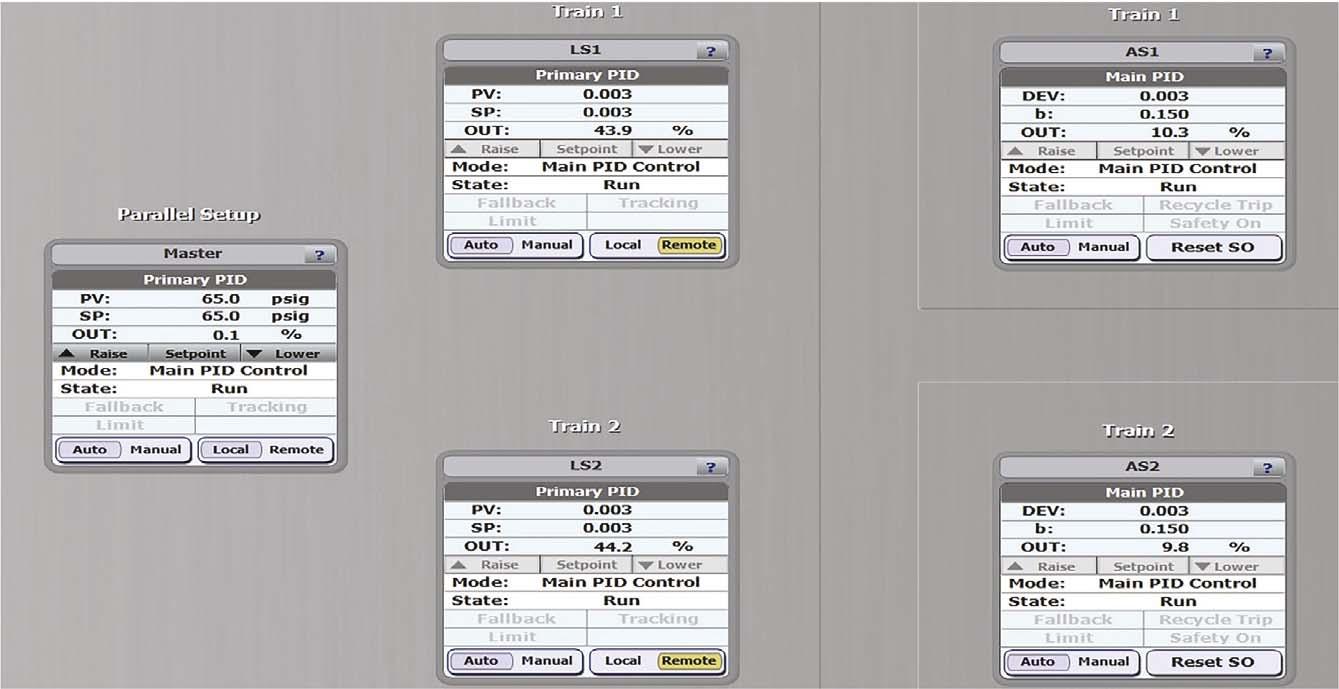
12 minute read
Optimising fl ow in parallel compressors




Nabil Abu-Khader, Compressor Controls Corp., UAE, explores the operation of parallel centrifugal compressors using surge control.
Acompressor map shows the characteristics, performance, and operational limits of a compressor, i.e. surge, choke, minimum, and maximum speeds (performance curves). The distance between the operating point and the surge control line (SCL) of a centrifugal compressor map cannot be easily determined using compressor manufacturers’ supplied data. This is because surge limit line (SLL) points can vary with inlet gas conditions, and mainly gas composition changes.
The introduced coordinates by Compressor Controls Corp. (CCC), which are reduced fl ow squared (q2 sr) vs reduced head (h pr) or compression ratio (Rc), do not contain measured variables that change with gas composition changes. This article presents the load-sharing, load-balancing, and recycle-balancing techniques for parallel centrifugal compressors based on CCC’s invariant coordinate space surge control map computation principle.

Proximity to surge and the invariant coordinates
In order to prevent compressor surge with minimum recycle or blowoff, an antisurge controller must accurately determine how close the compressor is operating to its surge limit. The antisurge controller can use a variety of functions to calculate proximity to surge, each of which represents a different set of simplifying assumptions to


defi ne a coordinate system in which the surge limit is invariant to process changes.
The reduced polytropic head (h pr) was derived from Equation 1 and Equation 2:
Rc = Pd⁄Ps (1)
(2)
Where Ps and Pd are pressure in suction and in discharge, respectively, of the compressor (or compressor stage) of interest (measured in units of absolute pressure), and Rc is the compression ratio. σ is the polytrophic exponent of the gas being processed, non-dimensional and is derived from Equation 3:
σ = (k – 1)⁄(k * η) (3)
Parameter (σ) can be assumed constant if gas composition and gas parameters remain reasonably constant within the operating range of the compressor, but it may be necessary to correct for gas composition changes in some cases. k is the average isentropic exponent of the gas being processed which, for ideal gas, equals the ratio of specifi c heats Cp and Cv, as shown in Equation 4:
k = Cp⁄Cv (4)
η is the polytropic effi ciency of the compressor (or compressor stage) of interest, η <1.
Using the defi nition of polytrophic process, σ can also be calculated using Equation 5:
hpr = ( ) Rc σ – 1 σ
Where Ts and Td are the temperature in suction and in discharge respectively of the compressor (or compressor stage) of interest, measured in units of absolute temperature.
On the other hand, the reduced fl ow squared (q2 sr) was also derived from Equation 6:
q2 sr = dpos ⁄Ps (6)
Where dpos is the differential pressure of the fl ow-measuring device at the suction side of the compressor (or compressor stage) of interest.
When the fl ow-measuring device is located in the discharge side of the compressor (dpod), a compensated reduced fl ow in suction (dpos) can be derived, as per Equation 7:
dpos = dpod (Pd⁄Ps). (Ts⁄Td) (7)
To develop the invariant coordinate space, the reduced fl ow squared (q2 sr ) is normally used in the X-coordinate. As a CCC rule of thumb, if the gas composition and gas parameters remain reasonably constant, then the Y-coordinate can be simplifi ed as the compression ratio (Rc). However, if the gas composition and gas parameters change dramatically then reduced head (h pr) should be used in the Y-coordinate. Within this ‘non-dimensional’ coordinate space, the angular distance between the operating point and the SLL (SS) can be calculated, as per Equation 8:
SS = SlopeOPL⁄SlopeSLL (8)
σ = log (Td⁄Ts)/log (Pd⁄Ps) (5)
Where SlopeOPL = h pr ⁄ q2 sr, op is the slope of the operating point line in the compressor map, while SlopeSLL = h pr ⁄ q2 sr, SLL is the slope of the surge point line in the compressor map.
The variable SS is calculated continuously in the antisurge controller. Since SS is less than 1 for normal operation, and SS is greater than 1 when the system is in surge, this allows for easy judgement of different compressor systems by using the same surge parameter variable. The antisurge controller continuously calculates how much the operating point deviates from SCL using the SS parameter considering the overall control margin (b). The new calculated parameter is well known as the deviation (DEV) and is typically being calculated as per Equation 9:
DEV = 1 – SS – b (9)
The DEV is positive when the operating point is to the right of the SCL. In this case, if
Figure 1. An example of a two-identical parallel compressor network.

the antisurge valve is not fully closed, the antisurge proportional-integral (PI) response should gradually close it. The DEV will have a value of zero at the SCL. The DEV will be negative when the operating point is to the left of the SCL. The controller will vary the position of the antisurge valve as needed to keep the operating point on or to the right of the SCL. In its closed-loop response, the antisurge controller will vary its output based on its PI tuning parameters and then might use its open-loop recycle trip response if the operating point crossed the recycle trip line (RTL) to protect the compressor from surge.
It should be noted that there are many cases where the antisurge valve opens even if the calculated DEV is positive. Examples include being in a process limit condition, receiving a compressor stop or emergency shutdown (ESD) request, or recycle-balancing with other trains in a parallel compressor network. These conditions, among others, override the DEV calculation loop, ‘forcing’ the antisurge valve to open.
Load-sharing and load-balancing
There are many methods used to implement load-sharing among parallel compressor control applications. One method is commonly known as the base-loading method, in which the operator would select the more effi cient train and ‘base-load’ it either at the maximum speed (for maximum fl ow) or at the maximum effi ciency (for minimum power consumption). Clearly, this method is not optimal as it requires operator intervention.
A second method is based on fl ow-balancing. There are many disadvantages to this method, including additional fl ow elements and controllers – which increases the capital cost – and a triple cascade control scheme (pressure into fl ow into speed), while for dissimilar trains one train might surge before the other, especially at low loads.
CCC’s equidistant from surge load-sharing/load-balancing method has mainly two responses: Load-sharing (primary capacity response): master controller’s pressure or flow control response is broadcasted to each train. If the DEV is positive, the primary capacity response manipulates the load-sharing controller final element, satisfying the master controller demand. If the DEV is negative or zero (this can also be tuned), the system manipulates the antisurge valve to further help with not getting the compressor into surge. Load-balancing response: each load-sharing controller selects the lowest DEV reported by any of its companion antisurge controllers and use it as a process variable (PV). These lowest DEVs are then reported to the master controller, which calculates the average
DEV and sends it back to each load-sharing controller as a common load-balancing SP. Each load-sharing controller calculates a proportional-integral-derivative (PID) load-balancing response to raise or lower the

Figure 2. Parallel compressor operation (load-balanced).
Figure 3. Parallel compressor operation while the load-sharing (LS) controllers are in soft manual mode (not load-balanced).
Figure 4. Parallel compressor operation with load-balancing gain equal to 0 (not load-balanced).




performance of the train to bring its DEV value equal to the master controller’s average DEV.
This method ensures that each compressor runs at the same distance from its SCL, preventing any parallel compressors from recycling until all are operating at their surge control limits and balances their loads when operating away from those limits.
Load-balancing simulation
Figure 1 shows the process being simulated with two-identical centrifugal compressors in parallel. There is a common master controller (MC) controlling header discharge pressure while each compressor train has its dedicated antisurge (AS) and load-sharing (LS) controllers.
The first step is to see how the two-identical compressor network operates at the same distance from surge in a load-balancing scheme. As shown in Figure 1, flow is divided between the two trains with both
AS valves closed. Altering the master SP while maintaining the header discharge throttle valve (FV-003) at 100% open will result in distributing of the load across both Figure 5. Parallel compressor operation (Train 1 is unloaded and Train 2 is running on trains and the maximum speed). network will still balance, as shown in Figure 2. The red line represents the SLL and the green line represents the SCL. The current speed for both compressors is 6500 rpm, delivering the same flow to the discharge header. The next step is to Figure 6. Parallel compressor operation with reduced plant demand (recycle-balancing disabled). vary the output of the LS controllers in soft manual mode. For example, reducing the output of LS1 to 55% will reduce Train 1 speed to 5870 rpm and increasing LS2 output to 85% will increase Train 2 speed to 6620 rpm, as shown in Figure 3. Each train will deliver different fl ow quantity. Since LS Figure 7. Parallel compressor operation with reduced plant demand (recycle-balancing controllers are in soft enabled). manual mode, there will be no balancing and each train will follow its own manually given output. The perception of using manual mode for LS controllers will paralyse the equidistant from surge technique. Next, the load-balancing gain can be put equal to 0 for both LS1 and LS2 before they are turned into automatic mode. It will be seen that both trains will increase their outputs/speeds in the same direction, as shown in Figure 4, to satisfy the master controller SP. The network will not balance since the load-balancing gains are set to 0. To load-balance the two trains again, the second step can be repeated and the load-balancing gains can be put equal to 1 for both LS1 and LS2. If LS1 and LS2 are turned into automatic mode, Train 1 will increase its speed from 5870 rpm to 6500 rpm and Train 2 will reduce its speed from 6620 rpm to 6500 rpm in order to balance the network on the received remote SP (average DEV) from the master controller. The network would balance and each train will deliver the same fl ow quantity, as was shown in Figure 2.


Figure 8. Parallel compressor operation with reduced plant demand (recycle-balancing enabled).
Recycle-balancing
For parallel compressor systems, the AS controllers can also equalise the recycle rates to avoid unnecessary recycling. If the load declines to a point where recycling becomes inevitable, the load-balancing will not ensure that the recycle rates are identical for all the compressors. In that case, recycle-balancing works to equalise the recycle. Each AS controller compares its output to the output of the parallel AS controller(s) and if its output is less, it will increase its own recycle rate to match the highest output.
Recycle-balancing simulation
For the same process described above, Train 1 can be unloaded. Here, Train 2 will be forced to increase its speed (to 7000 rpm) as shown in Figure 5, while trying to maintain the demand from the master controller since it is the only train left contributing to the discharge header.
Reducing the plant demand by closing the discharge header throttle valve (FV-003) from 100% to 70% should result in an increase in the header discharge pressure.
If Train 1 is loaded now it will enter the start-up sequence, increasing its speed and ramping its AS valve close. This will result in a further increase in the header discharge pressure. When the Train 1 AS controller enters the run state, and since the master header discharge pressure became more the SP, the master controller will command both trains to lower their speeds. This forces Train 1 to hit its SCL earlier than Train 2 and start to recycle to maintain its operating point on the SCL. Train 2 will ‘slowly’ load-balance with Train 1 at DEV equal to 0 without any recycling. Finally, Train 1 will recycle around 21% while Train 2’s AS valve will remain closed. The network will not recycle-balance, as shown in Figure 6, and each train will be running at its own speed and flow.
The next step is to unload Train 1 and then enable the recycle-balancing feature in both trains (the recycle-balancing rate can also be regulated).
After loading Train 1, both trains will end up sharing the required recycling to meet the reduced plant demand. This is accomplished by an AS valve opening of around 10% in each train. Both trains will have the same speed, flow, and recycling values. The network is both load- and recycle-balanced, illustrated in Figures 7 and 8.
Summary
CCC antisurge, load-sharing, and master controllers integrated applications can load-balance and recycle-balance centrifugal compressors running in parallel. Equalising the relative distance from surge, or DEV, is the best means for distributing fl ow amongst parallel compressors. Through this way dissimilar trains can easily be accommodated. In low plant demand circumstances and when recycling becomes inevitable, a recycle-balancing control strategy can be applied to further optimise parallel trains. Additional features within CCC controllers (such as performance override control [POC] and loop decoupling) can be used to further stabilise the process within its safe boundaries.
Bibliography
1. JACOBSON, W., et al., ‘Compressor Loadsharing Control and Surge
Detection Techniques’, paper given at 45th Turbomachinery & 32nd Pump Symposia for Turbomachinery Laboratory,
Texas A&M Engineering Experiment Station, Houston, Texas,
US (September 2016). 2. Compressor Controls Corp.; AN21 Load Sharing for Parallel
Compressor Networks (February 2014). 3. Compressor Controls Corp.; UM6411 and UM6412 Reference
Manuals (March 2019).










